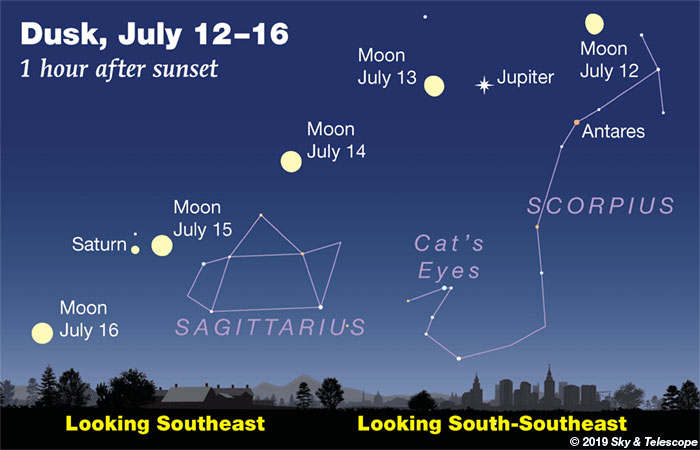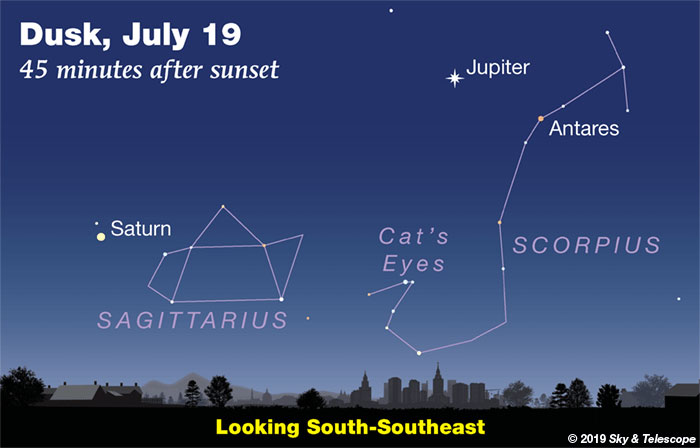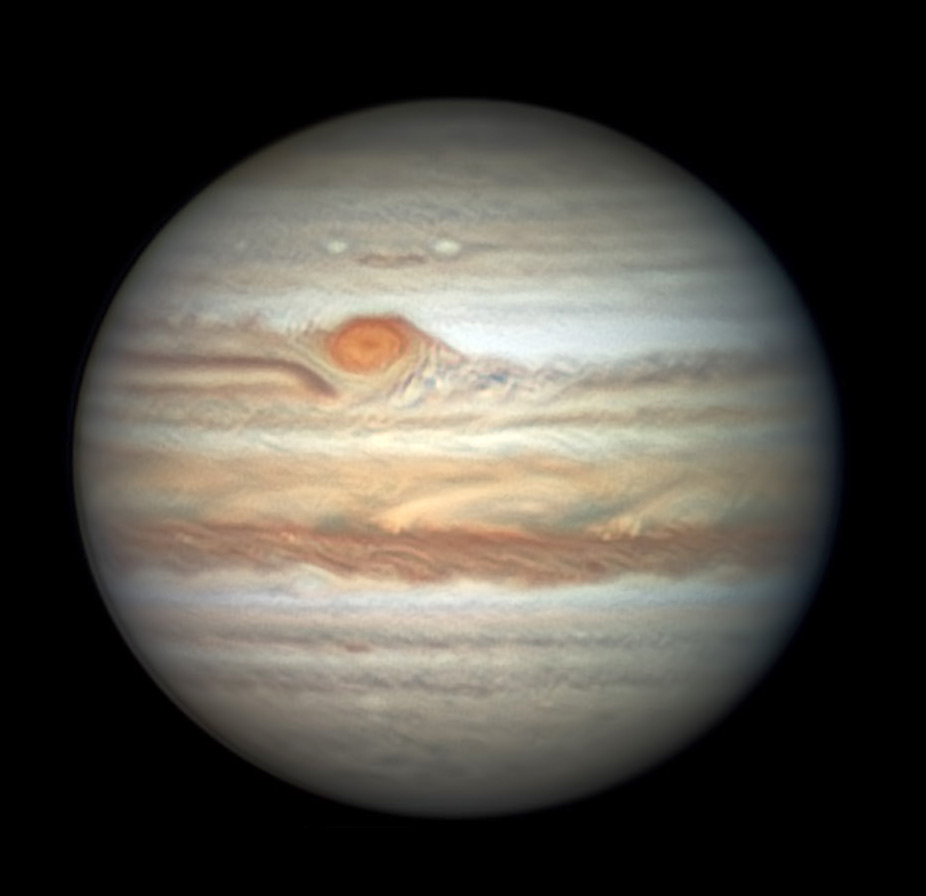
Friday, July 12
• The Moon this evening forms a triangle with Jupiter to its lower left and Antares under it, as shown above.
• Jupiter's Great Red Spot should cross the planet's central meridian around 11:08 p.m. Eastern Daylight Time. For the full schedule of this month's Red Spot transits, good worldwide, see the July Sky & Telescope, page 50.
Saturday, July 13
• The Moon and Jupiter cross the sky together tonight, as shown above. During this month's pairup of the two, Jupiter is 1,700 times farther than the Moon. In actuality the Moon is roughly the size of Jupiter's own four Galilean moons, mere pinpoints as seen in a small scope or with good, steadily braced binoculars. This evening for North America, all four appear on Jupiter's celestial west side relatively close to the planet.
Sunday, July 14
• Now the Moon shines between Jupiter and Saturn, as shown above. Notice how steadily the two planets glow compared to twinkly bright stars.
Monday, July 15
• The Moon accompanies Saturn across the sky tonight, as shown above. They appear just 2° or 3° apart for North America. Saturn is currently 3,400 times farther than the Moon — twice as distant as Jupiter.
Tuesday, July 16
• Full Moon (exact at 5:38 p.m. EDT). A partial lunar eclipse is visible from most of the world's continents except North America. Map, timetable, and full details.
For us in North America, the full Moon shines on just as normal as can be, about 10° east of Saturn.
Wednesday, July 17
• High in the northwest after dark, the Big Dipper has started its long, slow scoop toward the right. Lower in the north-northeast, meanwhile, the upright W of Cassiopeia has slowly begun to tilt and climb.
Thursday, July 18
• Week by week, bright Arcturus is losing some of its height in the west after dark.
Look for Spica to the lower left of Arcturus by about three fists at arm's length. Lower right of Arcturus by the same amount is Denebola, the tailtip of Leo. These three stars form an almost perfect equilateral triangle.

Friday, July 19
• The tail of Scorpius is low due south after dark, as shown above. How low depends on how far north or south you live: the farther south, the higher.
Look for the two stars especially close together in the tail. These are Lambda and fainter Upsilon Scorpii, known as the Cat's Eyes. They're canted at an angle; the cat is tilting his head and winking.
The Cat's Eyes point to the right by nearly a fist-width toward Mu Scorpii, a much tighter pair (shown as a single dot on the map) known as the Little Cat's Eyes. They're oriented almost exactly the same way as Lambda and Upsilon. Are your eyes sharp enough to resolve the Mu pair without using binoculars? Not many people can!
Saturday, July 20
• Scorpius is sometimes called "the Orion of Summer" for its brightness, its blue-white giant stars, and its prominent red supergiant (Antares in the case of Scorpius, Betelgeuse for Orion). But Scorpius passes a lot lower across the south than Orion does, for those of us at mid-northern latitudes. That means it has only one really good evening month: July.
Catch Scorpius due south just after dark now, before it starts to tilt lower toward the southwest. It's full of deep-sky objects to hunt with a sky atlas and binoculars or a telescope, before the waning gibbous Moon rises later tonight to light the sky.
• Once the Moon does rise in the east-southeast, contemplate the moment 50 years ago today when a man took the first step onto another world. The sunset terminator tonight is approaching Tranquillity Base, and everything there must be casting long shadows.
________________________
Want to become a better astronomer? Learn your way around the constellations. They're the key to locating everything fainter and deeper to hunt with binoculars or a telescope.
This is an outdoor nature hobby. For an easy-to-use constellation guide covering the whole evening sky, use the big monthly map in the center of each issue of Sky & Telescope, the essential guide to astronomy.

Once you get a telescope, to put it to good use you'll need a detailed, large-scale sky atlas (set of charts). The basic standard is the Pocket Sky Atlas (in either the original or Jumbo Edition), which shows stars to magnitude 7.6.
Next up is the larger and deeper Sky Atlas 2000.0, plotting stars to magnitude 8.5; nearly three times as many. The next up, once you know your way around, are the even larger Interstellarum atlas (stars to magnitude 9.5) and Uranometria 2000.0 (stars to magnitude 9.75). And read how to use sky charts with a telescope.
You'll also want a good deep-sky guidebook, such as Sue French's Deep-Sky Wonders collection (which includes its own charts), Sky Atlas 2000.0 Companion by Strong and Sinnott, or the bigger Night Sky Observer's Guide by Kepple and Sanner.
Can a computerized telescope replace charts? Not for beginners, I don't think, and not on mounts and tripods that are less than top-quality mechanically (meaning heavy and expensive). And as Terence Dickinson and Alan Dyer say in their Backyard Astronomer's Guide, "A full appreciation of the universe cannot come without developing the skills to find things in the sky and understanding how the sky works. This knowledge comes only by spending time under the stars with star maps in hand."
This Week's Planet Roundup
Mercury, Venus, and Mars are out of sight in the glare of the Sun. Mercury will be back in view in the dawn come August, but Venus and Mars are basically gone until October.

Jupiter (magnitude –2.5, in southern Ophiuchus) is the white point glaring in the south during and after dusk. Orange Antares, fainter at magnitude +1.0, twinkles 7° or 8° to its lower right.
Jupiter and Antares form a wide, shallow, almost isosceles triangle with Delta Scorpii (Dschubba) to their right. Delta, a long-term eruptive variable of the Gamma Cassiopeiae type, has been not much fainter than Antares for most of the last 19 years — after it brightened by some 50%, without warning, in July 2000.
In a telescope Jupiter is still a good 44 arcseconds wide. See Bob King's observing guide to Jupiter.
Saturn (magnitude +0.1, in Sagittarius) is just past its July 9th opposition. It's the steady, pale yellowish "star" in the southeast after dark, about 30° east (left) of Jupiter. To Saturn's lower right is the Sagittarius Teapot.
Saturn is highest for telescopic observing in the middle of the night — but still not very high for us northerners, because it's far south this year: around declination –22°. Saturn's rings are tilted a wide 23° to our line of sight, not quite as open as they've been for the last couple of years.
Uranus (magnitude 5.8, in Aries) is high in the east before the first beginnings of dawn.
Neptune (magnitude 7.8, in Aquarius) is high in the south by that time. Finder charts for Uranus and Neptune.
_________________
All descriptions that relate to your horizon — including the words up, down, right, and left — are written for the world's mid-northern latitudes. Descriptions that also depend on longitude (mainly Moon positions) are for North America.
Eastern Daylight Time (EDT) is Universal Time (UT, UTC, GMT, or Z time) minus 4 hours.
_________________
Audio sky tour. Out under the evening sky with your earbuds in place, listen to Kelly Beatty's monthly podcast tour of the heavens above. It's free.
_________________
“This adventure is made possible by generations of searchers strictly adhering to a simple set of rules. Test ideas by experiments and observations. Build on those ideas that pass the test. Reject the ones that fail. Follow the evidence wherever it leads, and question everything. Accept these terms, and the cosmos is yours.”
— Neil deGrasse Tyson, 2014
______________________
 0
0








Comments
You must be logged in to post a comment.